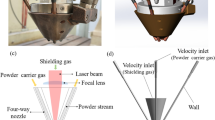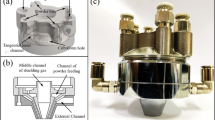Abstract
A 3D full size numerical model of a ring-type coaxial nozzle was established to obtain particle space trajectory and convergence character. The realizable k-ε model was applied in the gas flow phase. The powder flow was coupled with the gas flow by using Euler–Lagrange approach as a discrete phase model. Different powder material and particle sizes were selected to calculate the powder concentration distribution. The simulated powder stream morphology matched well with the experimental results of high-speed camera observations. Simulation results showed that using mean diameter \(\overline{\mathrm{d} }\) to replace Rosin–Rammler distribution of particle size could get accurate flowing characteristic results. Simulation results also showed that this substitution could save computational resources and reduce the computing time significantly. The presence of the coaxial shielding gas has direct impact on the powder mass concentration spatial distribution, maximum value convergence height, and spot size of the powder flow. For 316L with small particle size and Ni60A with large particle size, we found different change regularities and no linear relationship was found. Therefore, it is recommended not to change the input volume of coaxial shielding gas without special needs. Simulation results, combining with the laser cladding experiments of Ni60A, have demonstrated that the developed ring-type coaxial nozzle could transport powder efficiently and form excellent deposited layers. The conditional powder utilization ratio can be as good as 75.9%.












Similar content being viewed by others
Availability of data and material
The datasets used or analyzed during the current study are available from the corresponding author on reasonable request.
References
Tamanna N, Crouch R, Naher S (2019) Progress in numerical simulation of the laser cladding process. Opt Lasers Eng 122:151–163. https://doi.org/10.1016/j.optlaseng.2019.05.026
Li L, Huang Y, Zou C, Tao W (2021) Numerical study on powder stream characteristics of coaxial laser metal deposition nozzle. Curr Comput-Aided Drug Des 2021(11):282. https://doi.org/10.3390/cryst11030282
Li C, Zhang D, Yang Y, Gao H, Han X (2021) Research on sputtering behavior of three beams coaxial laser cladding powder based on the interaction of lasers and powder. J Laser Appl 33(4):042020. https://doi.org/10.2351/7.0000449
Zhu G, Li D, Zhang A, Tang Y (2011) Numerical simulation of metallic powder flow in a coaxial nozzle in laser direct metal deposition. Opt Laser Technol 43(1):106–113. https://doi.org/10.1016/j.optlastec.2010.05.012
Arrizubieta JI, Tabernero I, Ruiz JE, Lamikiz A, Martinez S, Ukar E (2014) Continuous coaxial nozzle design for lmd based on numerical simulation. Phys Procedia 56(56):429–438. https://doi.org/10.1016/j.phpro.2014.08.146
Tabernero I, Lamikiz A, Ukar E, De Lacalle LL, Angulo C, Urbikain G (2010) Numerical simulation and experimental validation of powder flux distribution in coaxial laser cladding. J Mater Process Technol 2010(210):2125–2134. https://doi.org/10.1016/j.jmatprotec.2010.07.036
Liu Z, Qi H, Jiang L (2016) Control of crystal orientation and continuous growth through inclination of coaxial nozzle in laser powder deposition of single-crystal superalloy. J Mater Process Technol 2016(230):177–186. https://doi.org/10.1016/j.jmatprotec.2015.11.017
Zhang J, Yang L, Li Z, Zhang Q, Yu M, Fang C, Xiao H (2021) Transport phenomenon, flow field, and deposition forming of metal powder in the laser direct deposition with designed nozzle. Int J Adv Manuf Technol 114(1). https://doi.org/10.1007/s00170-021-06913-x
Kovalev OB, Zaitsev AV, Novichenko D, Smurov I (2011) Theoretical and experimental investigation of gas flows, powder transport and heating in coaxial laser direct metal deposition (DMD) process. J Therm Spray Technol 20:465–478. https://doi.org/10.1007/s11666-010-9539-3
Hua T, Fengying Z, Xin Fu, Jian M, Guang Hu, Wei F, Huang W (2016) Development of powder flow model of laser solid forming by analysis method. The International Journal of Advanced Manufacturing Technology. https://doi.org/10.1007/s00170-015-7481-8
Popovich A, Sufiiarov V, Polozov I, Borisov E, Masaylo D, Orlov A (2016) Microstructure and mechanical properties of additive manufactured copper alloy. Mater Lett 179:38–41. https://doi.org/10.1016/j.matlet.2016.05.064
Higashino R, Sato Y, Masuno S, Shobu T, Funada Y, Abe N, Tsukamoto M (2020) Development of blue diode laser for additive manufacturing. Laser 3D Manufacturing VII. https://doi.org/10.1117/12.2543119
Fan J, Zhao H, Cen K (1992) An experimental study of two-phase turbulent coaxial jets. Exp Fluids 1992(13):279–287. https://doi.org/10.1007/BF00189021
Fluent Inc. (2018) FLUENT 19.0 User Guide
Kim SE, Choudhury D, Patel B (1999) Computations of complex turbulent flows using the commercial code fluent. In: Salas M.D., Hefner J.N., Sakell L. (eds) Modeling Complex Turbulent Flows. ICASE/LaRC Interdiscip Ser Sci Eng 7. Springer, Dordrecht. https://doi.org/10.1007/978-94-011-4724-8_15
Shih TH, Liou WW, Shabbir A, Yang Z, Zhu J (1994) A New k-(Eddy viscosity model for high reynolds number turbulent flows - model development and validation. Comput Fluids 24
Gosman AD, Ioannides E (2022) Aspects of computer simulation of liquid-fuelled combustors
Thomy C, Seefeld T, Vollertsen F (2008) Humping effect in welding of steel with single-mode fibre laser. Welding in the World 52.5–6(2008):9–18. https://doi.org/10.1007/BF03266636
Tong X, Li F, Liu M, Dai M, Zhou H (2010) Opt Laser Technol 42:1154
Steen WM (1998) Laser Materials Processing, second edition. Springer
Zekovic S, Dwivedi R, Kovacevic R (2007) Numerical simulation and experimental investigation of gas–powder flow from radially symmetrical nozzles in laser-based direct metal deposition. Int J Mach Tools Manuf 47(1):112–123. https://doi.org/10.1016/j.ijmachtools.2006.02.004
Yang N (2009) Concentration model based on movement model of powder flow in coaxial laser cladding. Opt Laser Technol 41:94–98. https://doi.org/10.1016/j.optlastec.2008.03.008
Zhang J, Yang L, Zhang W, Qiu JB, Xiao HB, Yang L (2020) Numerical simulation and experimental study for aerodynamic characteristics and powder transport behavior of novel nozzle. Opt Lasers Eng 126:105873. https://doi.org/10.1016/j.optlaseng.2019.105873
Hemmati I, Ocelík V, De Hosson JTM (2011) The effect of cladding speed on phase constitution and properties of AISI 431 stainless steel laser deposited coatings. Surf Coat Technol 205.21(2011):5235–5239. https://doi.org/10.1016/j.surfcoat.2011.05.035
Fs A, Wang TA, Ll A, Yz A, Wei WB, Sw B (2020) Effect of microstructure on the corrosion resistance of coatings by extreme high speed laser cladding. Appl Surf Sci. https://doi.org/10.1016/j.apsusc.2020.146085
Chen Z, Li R, Gu J, Zhang Z, Tao Y, Tian Y (2019) Laser cladding of ni60 + 17 4ph composite for a cracking-free and corrosion resistive coating. Int J Mod Phys B 34(1n03):2040042. https://doi.org/10.1142/S0217979220400421
Funding
This work was funded by Guangdong Province Key Field Research and Development Program Project (2020B090924002), National Natural Science Foundation of China (U2001218), Guangdong Province Joint Key Fund of Guangdong and Shenzhen (2020B151520013), and Guangdong Province Basic and Applied Basic Research Fund Project (2019B1515120094).
Author information
Authors and Affiliations
Contributions
Conceptualization, H.Z., Y.Y., S.Z., Y.L., D.W., Z.T. Data curation, H.Z., Y.L., D.W., G.D., Z.T. Form analysis, H.Z., D.W., Y.L. Funding acquisition, Y.Y. Investigation, D.W., H.Z., Y.L. Methodology, H.Z., D.W., Y.L. Project administration, Y.Y. Supervision, S.Z., D.W. Writing, original draft, H.Z. Writing, review and editing, D.W., Y.L., H.Z.
Corresponding authors
Ethics declarations
Ethics approval
Not applicable.
Consent to participate
Not applicable.
Consent for publication
Not applicable.
Conflicts of interest
The authors declare there no competing interests.
Additional information
Publisher's Note
Springer Nature remains neutral with regard to jurisdictional claims in published maps and institutional affiliations.
Rights and permissions
About this article
Cite this article
Zhou, H., Yang, Y., Wang, D. et al. Powder flow simulation of a ring-type coaxial nozzle and cladding experiment in laser metal deposition. Int J Adv Manuf Technol 120, 8389–8400 (2022). https://doi.org/10.1007/s00170-022-09175-3
Received:
Accepted:
Published:
Issue Date:
DOI: https://doi.org/10.1007/s00170-022-09175-3




